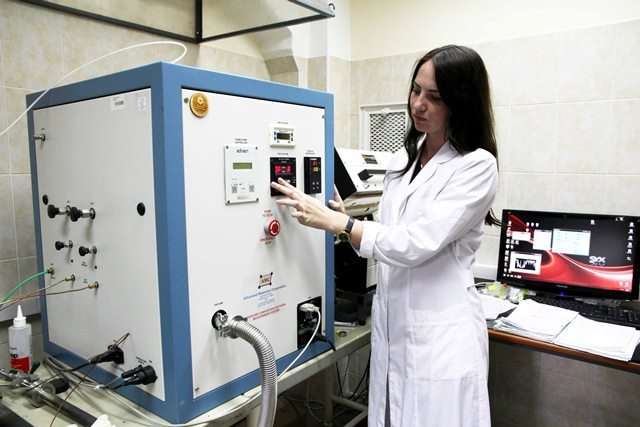3-D printing of aircraft parts out of titanium

Physicists from Tomsk Polytechnic University are currently working to create hydrogen-resistant products out of titanium alloys based on additive manufacturing. The production of metal products using the technology ensures less material consumption as well as possibilities to develop complex geometric products. The project is led by Associate Professor Natalia Pushilina at the Department of General Physics.
Today, titanium products are widely used in aircraft construction due to their strength. Thus, titanium parts account for 15 to 20 percent of a modern civil aircraft. These parts are produced in traditional foundries. TPU physicists are now showing the advantages of producing titanium parts using advanced additive technology.
"In Russia it is a fairly new technology. To introduce it, special 3-D-printing equipment and powder production installation should be developed. Thus, there is a great scope for research," explains the scientific leader of the project Natalia Pushilina. "Meanwhile, this equipment is increasingly in high demand as evidenced by the great number of scientific publications devoted to additive manufacturing technology in the field of metal processing. Over the past few years, their number has significantly increased in leading scientific publication databases, which signifies a great interest in the international community."
TPU researchers plan to print aircraft parts out of BT6 and BT9 titanium alloys. The former is a widespread material being produced in Russia. The latter is being developed by TPU out of crystalline titanium.
"For the research, we chose these two materials, which have been applied in aircraft construction due to their properties. Thus, BT6 is used to manufacture turbine parts subject to high temperatures, corrosive media and saturation with atmospheric hydrogen during operation," says Natalia Pushilina.
According to the researchers, 3-D-printing with titanium alloys differs from foundry process in that it relies on additive manufacturing technology that makes it possible to make parts of any configuration, even the most complicated, thus consuming much less material.
"Titanium alloys are very difficult to process. Accordingly, it is very hard to manufacture parts with complex geometric shapes using standard technology. With 3-D-technology you can print any part. This goes beyond mass production supported by plants that daily cast a great deal of products. Our goal is to develop a technology for printing individual complex parts out of titanium," explains engineer Viktor Kudiyarov.
TPU scientists are determined to reveal patterns between various print parameters and characteristics of manufactured items, and have now identified over 10 parameters. By varying them, it is possible to obtain products with different specified properties. An essential part of the future technology is the creation of a gradient structure at the surface layer of the product.
"Our technology allows the production of parts with uniform thickness throughout and parts with a modified surface layer. The modification of the upper layer will improve the properties of the products. For example, it will make them more wear-resistant, more resistant to hydrogen," says Viktor Kudiyarov.
Such modifications require an additional production process. First, a homogeneous part is made, then an additional coating is applied. The technology developed by the TPU scientists will allow combining these two processes—details will be printed immediately with a modified layer. The team of the Department of General Physics will study technological modes and properties of the samples obtained, and 3-D printing will be carried out at the Scientific and Educational Center Modern Production Technologies.
Provided by Tomsk Polytechnic University





















